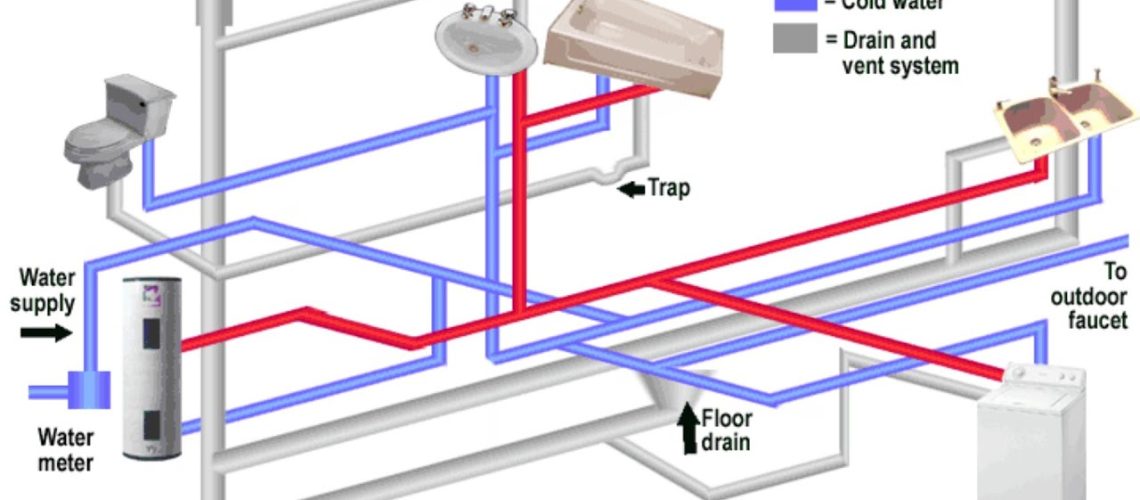Introduction
Home plumbing systems can be intricate and multifaceted, comprising various components that work together to deliver clean water and remove wastewater. Understanding how your home’s plumbing system operates is essential for effective maintenance and troubleshooting. This guide aims to simplify these concepts, providing homeowners with the knowledge they need to manage their plumbing effectively and prevent costly repairs.
Basic Components
Water Supply System
The water supply system is the backbone of your home’s plumbing and is responsible for bringing fresh water from the municipal supply or a well into your home.
- How Water Enters the Home: Water enters your home through a main supply line, which branches off to various fixtures. Pressure from the water supply pushes water through pipes, ensuring it reaches your sinks, showers, and appliances.
- Components: This system includes the main shutoff valve, which allows you to turn off the water supply in emergencies, and various pipes that distribute water throughout your home.
Drainage System
The drainage system is equally critical, transporting wastewater away from your home.
- How Wastewater Exits: Wastewater flows from fixtures through drainpipes and into the sewer system or a septic tank. Gravity plays a crucial role in this system, guiding waste downwards and away from your home.
- Components: Key components include vent pipes that allow air into the system to prevent vacuum formation and traps that hold water to prevent sewer gases from entering your home.
Types of Pipes
Understanding the types of pipes used in plumbing can help you make informed decisions about repairs and upgrades.
PVC (Polyvinyl Chloride)
- Uses: Commonly used for drain, waste, and vent systems.
- Pros: Lightweight, resistant to corrosion, and easy to install.
- Cons: Not suitable for hot water lines and can become brittle with age.
Copper
- Uses: Often used for water supply lines and some drainage applications
- Pros: Durable, heat-resistant, and has natural antimicrobial properties.
- Cons: Expensive and can corrode over time if not properly installed.
PEX (Cross-Linked Polyethylene)
- Uses: Increasingly popular for water supply lines and retrofitting.
- Pros: Flexible, resistant to freezing, and easy to install with fewer fittings.
- Cons: Susceptible to UV light and may not be suitable for outdoor use.
Fixtures and Appliances
Common Fixtures
- Sinks: Essential in kitchens and bathrooms, sinks come in various styles and materials, impacting installation and maintenance.
- Toilets: These fixtures use water to flush waste and can vary in efficiency and design.
- Showers: Shower systems can range from simple setups to complex multi-function models.
Major Appliances
- Water Heaters: These appliances are crucial for providing hot water for various household needs. Regular maintenance, such as flushing the tank, is essential to prevent sediment buildup.
- Dishwashers: Often connected to your plumbing, understanding how dishwashers work can help you troubleshoot issues like leaks or drainage problems.
Common Plumbing Terminology
Familiarizing yourself with key plumbing terms can enhance your understanding and facilitate communication with professionals.
Key Terms
- Backflow: The unwanted reversal of water flow, which can contaminate your water supply.
- Venting: A system of pipes that allows air to enter the plumbing system, preventing vacuum formation and ensuring proper drainage.
- Trap: A U-shaped pipe that holds water to prevent sewer gases from entering your home.
Understanding these terms can help you articulate plumbing issues more effectively when speaking to professionals.
Troubleshooting Basic Issues
Many plumbing problems can be diagnosed and addressed by homeowners, saving time and money.
Simple Problems to Troubleshoot
- Clogs: Kitchen sinks and bathroom drains can become clogged due to debris. Using a plunger or a plumber’s snake can often resolve these issues.
- Leaks: Leaky faucets or pipes can often be fixed by replacing washers or tightening connections. Always turn off the water supply before attempting repairs.
- Low Water Pressure: This issue can result from mineral buildup in faucets or pipes or issues with the water supply. Cleaning aerators and checking for leaks can help restore pressure.
When to Call a Professional
While many issues can be resolved DIY-style, some situations warrant professional help. If you encounter persistent leaks, significant water pressure problems, or complex repairs, it’s best to consult a licensed plumber.
Conclusion
Understanding the basics of your home’s plumbing system is crucial for effective maintenance and troubleshooting. By familiarizing yourself with the components, types of pipes, common fixtures, and essential terminology, you can better manage your plumbing needs and prevent costly repairs. We encourage you to take an active interest in your home’s plumbing system—knowledge is your best tool for keeping everything running smoothly!

